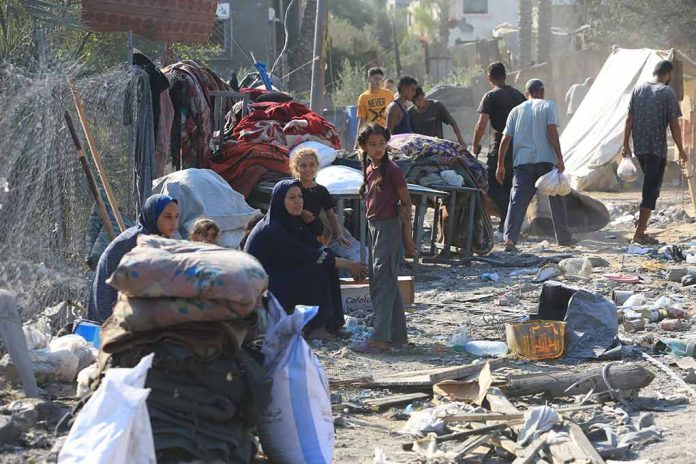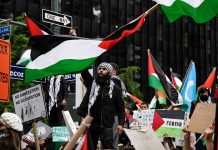
The death of 14 aid workers in Khan Younis has sparked international outrage as evidence emerges suggesting execution-style killings by Israeli forces, raising serious questions about violations of humanitarian law in the ongoing Gaza conflict.
Key Takeaways
- 14 aid workers were found dead in a mass grave near Rafah with evidence suggesting close-range execution.
- Bodies showed signs of being deliberately targeted with some reportedly found with hands bound and multiple gunshot wounds to the head and chest.
- Israeli forces claim they targeted vehicles they believed contained Hamas operatives, while aid organizations maintain the workers were clearly marked as humanitarian personnel.
- The incident has prompted rare direct accusations from the United Nations against Israel for killing humanitarian workers protected under international law.
- The tragedy highlights the growing danger for medical personnel in Gaza, with reports indicating over 1,000 medical staff deaths since October 2023.
Details of the Khan Younis Incident
The bodies of 14 aid workers were discovered in what has been described as a mass grave near Rafah in Gaza. According to forensic examination, many victims showed signs of execution-style killings with multiple gunshot wounds at close range. The workers were reportedly on a humanitarian mission to rescue injured civilians and missing paramedics when communications with their team were suddenly lost. It took five days of negotiations to secure safe passage for a retrieval team, which eventually found the bodies.
Among the victims was Anwar al-Attar, a respected Civil Defense worker known for his dedication to humanitarian efforts despite having been injured three times during previous rescue operations. Reports indicate his helmet and vest had over 20 bullet holes, despite being clearly marked Civil Defense equipment. The Gaza Ministry of Health and Civil Defense have accused Israeli forces of deliberately executing the aid workers.
The latest horror out of Gaza shows both sides of the conflict continuing to openly flout intl rules of war with the IDF killing clearly identified paramedics & UN aid workers while Hamas still refuses to release the remaining hostages.
How can this be allowed to continue pic.twitter.com/JOziSNadwL
— David Pocock (@DavidPocock) March 31, 2025
Conflicting Accounts of the Incident
The Israeli Defense Forces stated they targeted vehicles they believed were being used by Hamas and Islamic Jihad terrorists, acknowledging some were ambulances and fire trucks. According to Israeli claims, nine of the 15 dead were Palestinian militants. This account has been directly contradicted by Munther Abed, the sole survivor of the attack, who maintains that the ambulances followed all safety protocols and were clearly marked as medical vehicles.
“During day and at night, it’s the same: external and internal lights are on. Everything tells you it’s an ambulance that belongs to the Palestinian Red Crescent. All the lights were on until we came under direct fire,” Abed said.
Forensic doctor Ahmad Dhaher, who examined the bodies, reported evidence that strongly suggests execution-style killings. “All cases had been shot with multiple bullets, except for one, which could not be determined due to the body being mutilated by animals like dogs, leaving it almost as just a skeleton,” Dr. Dhaher stated. Witnesses also reported seeing bodies with tied hands and legs, suggesting detention before death, though this could not be confirmed due to decomposition.
International Response and Legal Implications
The incident has prompted unusually direct accusations from international organizations. The United Nations humanitarian chief, Tom Fletcher, explicitly stated that the workers “were killed by Israeli forces while trying to save lives,” adding, “We demand answers & justice.” The Red Crescent, International Committee of the Red Cross, and the United Nations have emphasized that the victims were humanitarian workers who should have been protected under international law.
UK Foreign Secretary David Lammy called the deaths “a stark reminder” that “those responsible must be held accountable.” The incident highlights the growing danger for humanitarian workers in Gaza, with The Guardian reporting over 1,000 medical staff deaths since the conflict began in October 2023. Civil Defense and Red Crescent crews, who are supposed to have international immunity under humanitarian law, appear to have had that protection disregarded in this case.
Broader Context of the Gaza Conflict
This incident occurs as Israel has intensified its military campaign in Gaza, with reports indicating efforts to divide the territory and establish a security corridor. According to Palestinian sources, the Israeli military has conducted new strikes in Khan Younis and Rafah in recent days.
The Khan Younis tragedy has become a focal point for international scrutiny regarding the conduct of military operations in Gaza and adherence to principles of international humanitarian law. As investigations continue, questions remain about accountability for the deaths of workers engaged in humanitarian missions in one of the world’s most dangerous conflict zones.









